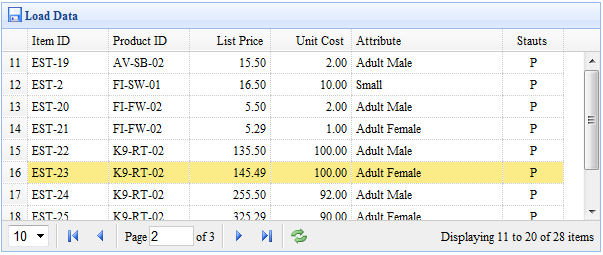
jQuery EasyUI 数据网格 – 添加分页组件
jQuery EasyUI 数据网格 - 添加分页组件
你可以向jQuery EasyUI数据网格(datagrid)添加分页组件(pagination)。
下述的示例演示了如何从服务器端加载数据,如何添加分页组件到数据网格。

创建数据网格(DataGrid)
为了从远程服务器端加载数据,您应该设置'url'属性,在您的服务器端应该返回JSON格式数据。请看数据网格文档得到更多关于它的数据格式信息。
<table id="tt" class="easyui-datagrid" style="width:600px;height:250px" url="datagrid2_getdata.php" title="Load Data" iconCls="icon-save" rownumbers="true" pagination="true">
<thead>
<tr>
<th field="itemid" width="80">Item ID</th>
<th field="productid" width="80">Product ID</th>
<th field="listprice" width="80" align="right">List Price</th>
<th field="unitcost" width="80" align="right">Unit Cost</th>
<th field="attr1" width="150">Attribute</th>
<th field="status" width="60" align="center">Stauts</th>
</tr>
</thead>
</table>我们定义数据网格列,并设置'pagination'属性为true,它将在数据网格的底部生成一个分页(pagination)工具栏。pagination将发送两个参数到服务器:
- page:页码,起始值1。
- rows:每页显示行。
服务器端代码
$page = isset($_POST['page']) ? intval($_POST['page']) : 1;
$rows = isset($_POST['rows']) ? intval($_POST['rows']) : 10;
// ...
$rs = mysql_query("select count(*) from item");
$row = mysql_fetch_row($rs);
$result["total"] = $row[0];
$rs = mysql_query("select * from item limit $offset,$rows");
$items = array();
while($row = mysql_fetch_object($rs)){
array_push($items, $row);
}
$result["rows"] = $items;
echo json_encode($result);